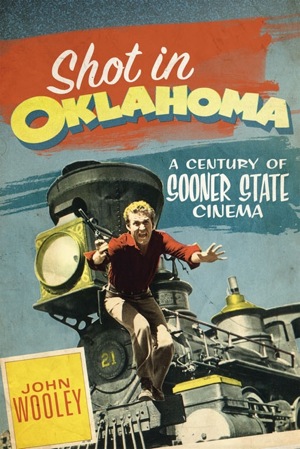Click here to print
A Century of Sooner Cinema
posted September 3, 2011
 Shot in Oklahoma: A Century of Sooner State Cinema by John Wooley (University of Oklahoma Press)
Shot in Oklahoma: A Century of Sooner State Cinema by John Wooley (University of Oklahoma Press)
A former entertainment writer with the Tulsa World and author, co-author, or editor of more than 20 books traces the history of cinema in Oklahoma since 1904, when a Thomas Edison crew came from New Jersey to film cowboys and Indians on the 101 Ranch near Ponca City.
Wooley describes films from early all-black movies shot in African-American communities and others with Native Americans as leads, through to mainstream blockbusters like Twister and cult movies like the Tulsa-shot Blood Cult, the first made-for-home-video feature. He interviews important figures in the state’s film history such as novelist S.E. Hinton, whose novel The Outsiders became a 1983 Francis Ford Coppola movie with then-young Tom Cruise and Matt Dillon, and he relates many you-are-there stories from newspaper accounts stretching baxck to the 1910s. Wooley provides backstories for many films, such as the one about how President Theodore Roosevelt’s fascination with a man purportedly able to catch a wolf in his hands led to The Wolf Hunt, shot in the Wichita Mountains and screened in the White House in 1909. The book includes a filmography of more than 100 productions filmed in the OK state.
John Wooley talks about archival issues relating to his book
While many of the made-in-Oklahoma films, even the obscure ones, were relatively easy to find and purchase, some of the earlier ones were not. Of course, since they started around 1904, a lot are lost, but the Oklahoma Historical Society came through with viewings of a few key titles that were of enormous benefit to the book.
Two of those, both of which the Society has restored, are The Passing of the Oklahoma Outlaw and Daughter of Dawn. The first is a four-reeler made in 1915 by a U.S. Marshal named Bill Tilghman, mostly because he and his fellow lawmen were upset with a film spawned by one of their local outlaws, Al Jennings, called Beating Back.
The other is an all-Native American picture from 1920, with tinted scenes, that never got much of a release. The Society is currently having a full soundtrack recorded for it.
The OHS also has a copy of The Kidnappers Foil, which is a two-reel kid comedy an itinerant filmmaker named Melton Barker shot over and over again with different casts as he traveled through middle America. The Society print also features reminiscences from former children who played in the picture. It was fascinating and illuminating material.
One relatively recent movie that didn’t have an official DVD or VHS release at the time was Stark Fear, a 1962 psychological thriller made by Oklahoma filmmakers with a nice B-picture cast: Beverly Garland, Skip Homeier, and Kenneth Tobey. As it happened, the local PBS affiliate had given it a “world TV premiere” a few years back, and I’d had the foresight to tape it.
Finally, it took me a long time to run down a little picture shot in Tulsa called Just Between Us (1960), featuring a German shepherd named London who’d been in a couple of other features, notably 1958’s The Littlest Hobo. I found a newspaper photo spread on Just Between Us in the vertical files at Tulsa’s Central Library, which led me to a few contemporary Tulsa Tribune columns about it. But – since it apparently never got a release outside of Tulsa – I couldn’t find much of anything else. However, I contacted the son of the columnist who had originally written about it, and he remembered London and a publicity stunt held in conjunction with the Tulsa premiere, involving one of London’s sons parachuting from an airplane(!).
Armed with every scrap of information on the film I could find, I devoted one of my monthly Oklahoma Magazine columns to it – and the woman who’d starred in the picture as a little girl contacted me! She had a VHS copy, taken from the original 35mm print and given to her by the film’s backer. She was happy, if a bit puzzled, to see the movie talked about in print after a half-century, and I was delighted to be able to see it and write about it myself. You can bet I included plenty of reminiscing from its star.
Printed from Moving Image Archive News: http://www.movingimagearchivenews.org
URL to article: http://www.movingimagearchivenews.org/a-century-of-sooner-cinema/
Click here to print